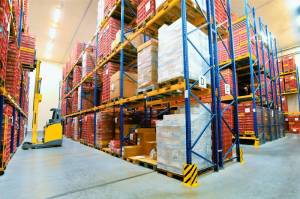
Jungheinrich has equipped a freezer warehouse at the Stadtbäckerei Junge bakery chain with its own RFID technology, making processes at this highly modern, 110-year old company even more efficient. The Jungheinrich solution moreover adds up to significantly greater security for production and warehouse stocks.
In the spring of 2009 Jungheinrich successfully implemented a tailored RFID solution for Stadtbäckerei Junge. For this Jungheinrich solution an RFID reader was mounted on the fork carriage of a Jungheinrich ETV 214 reach truck. This cold store version of the truck was furthermore equipped with a wireless PC and a barcode scanner (each with its own integrated heater) for identifying the pallet IDs. Transponders were positioned on each pallet storage slot on the shelves; for floor-level storage slots they were glued to the floor.
The driver, not the warehouse administration system, determines the storage location.
How the process works: The article to be stored is tagged in the incoming goods department with a slip containing the article information and a barcoded ID number. When the pallet ID is scanned, the article is logged into the warehouse management system (WMS), then brought to the freezer warehouse using the reach truck. In the warehouse itself the driver needs only to find the first available storage slot. As soon as the driver is ready to unload the pallet there, he simply presses a button on the heated terminal display. This activates the RFID reader which is located between the two forks. While the article is being stored, this reader reads the transponder mounted on the storage slot or floor, thus matching the pallet ID to the storage location.
This information is automatically communicated back to the WMS system, which then "knows" exactly where each item is located in the warehouse. Since the location is not pre-assigned by the warehouse management system, the driver has the freedom to choose his preferred location. When the article is taken out of storage, the driver removes the pallet specified by the WMS system. The storage location is again identified via RFID and the pallet is logged out of the WMS system. This means the pallet space is freed up not only physically, but also within the system itself.
"This Jungheinrich solution has helped us further improve our efficiency," reports Tim Elsholz, Assistant Production Manger at Stadtbäckerei Junge. The company already noticed the difference directly following project completion in spring 2009. On the one hand, the solution made life easier for warehouse staff; on the other it resulted in significantly greater security for production and warehouse stock. Elsholz explains: "Our production plans and with them our work planning schedules are strongly geared to the level of warehouse stocks."
All parties involved speak today of a successful project and smooth cooperation in getting there. First-rate service was of the essence due to the highly technical nature of the project. "I'm familiar with the level of service provided by other mechanical engineering firms," says Elsholz. "Some of them are not very capable, others are good. Jungheinrich is outstanding!"
Jungheinrich is among the leading international companies in the industrial truck, warehousing and materials handling sector. As a producing logistics service provider it offers its customers a comprehensive product range consisting of stackers, rack systems, services and consulting for complete intralogistics. The Jungheinrich share is traded on all German stock exchanges.